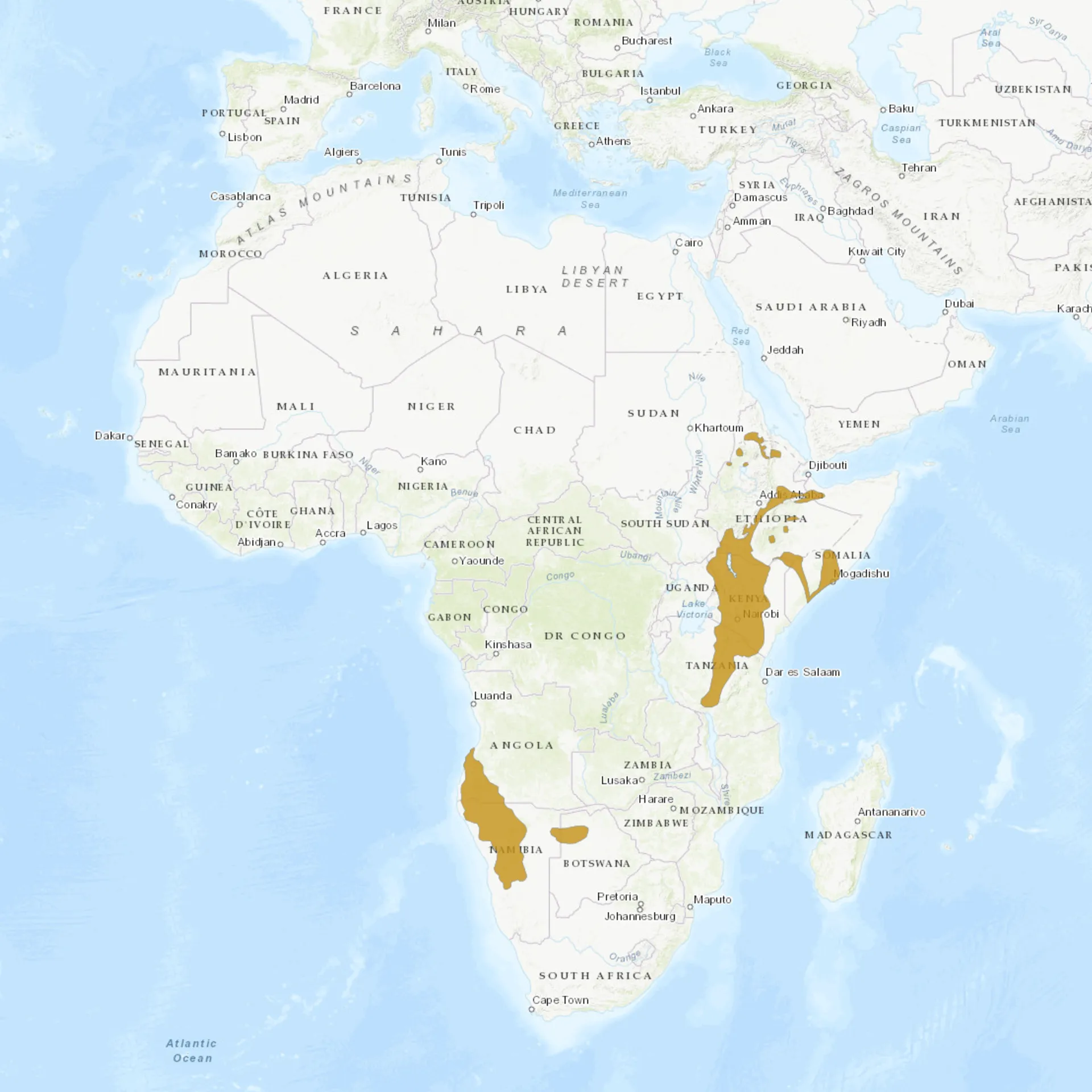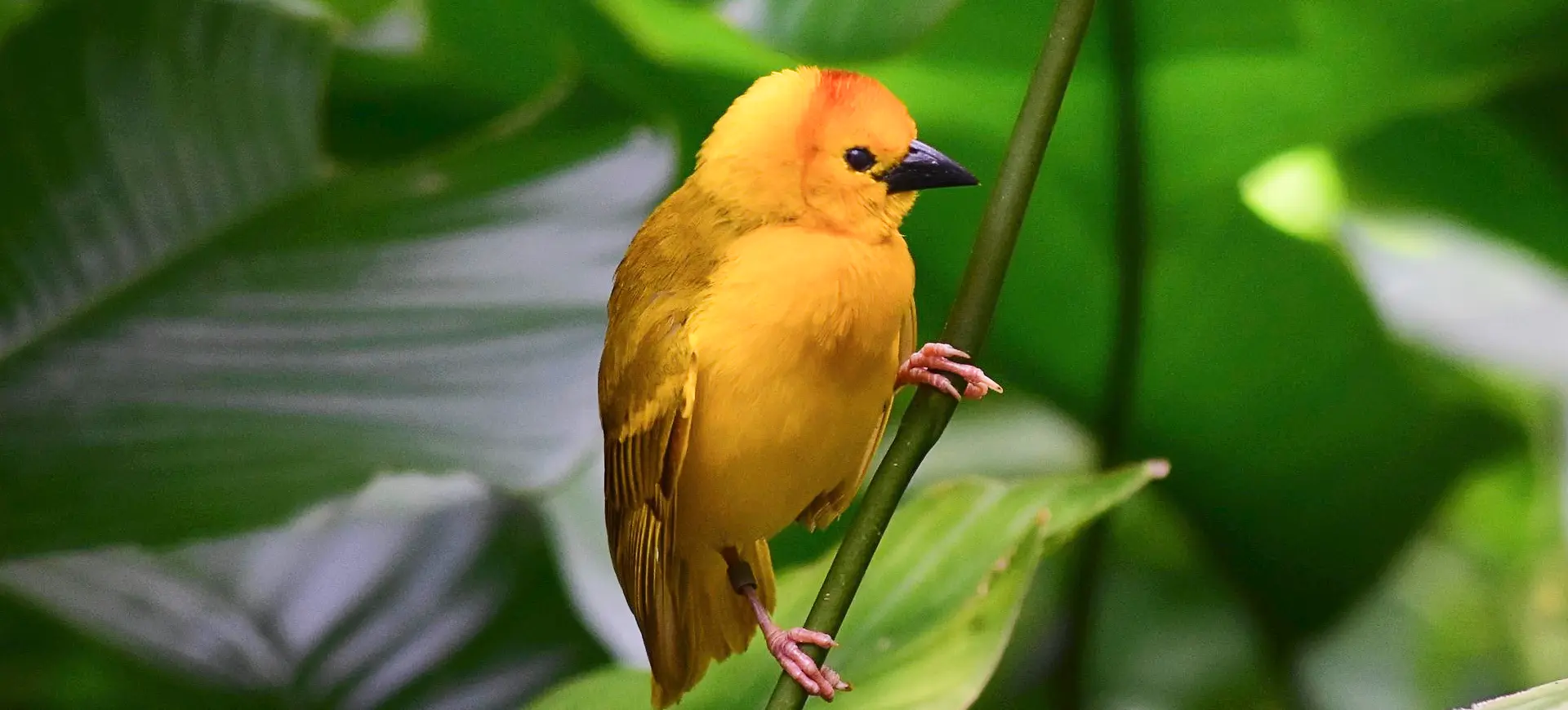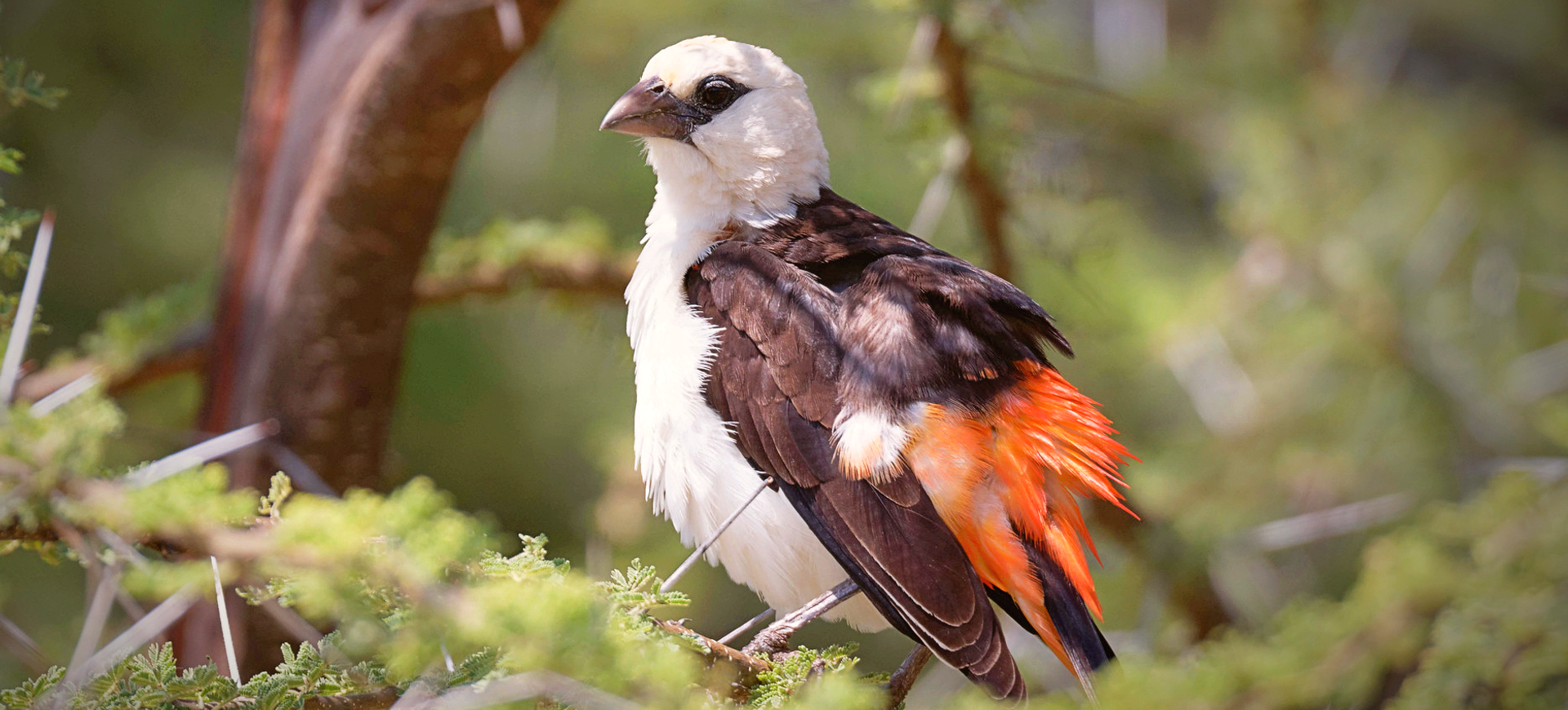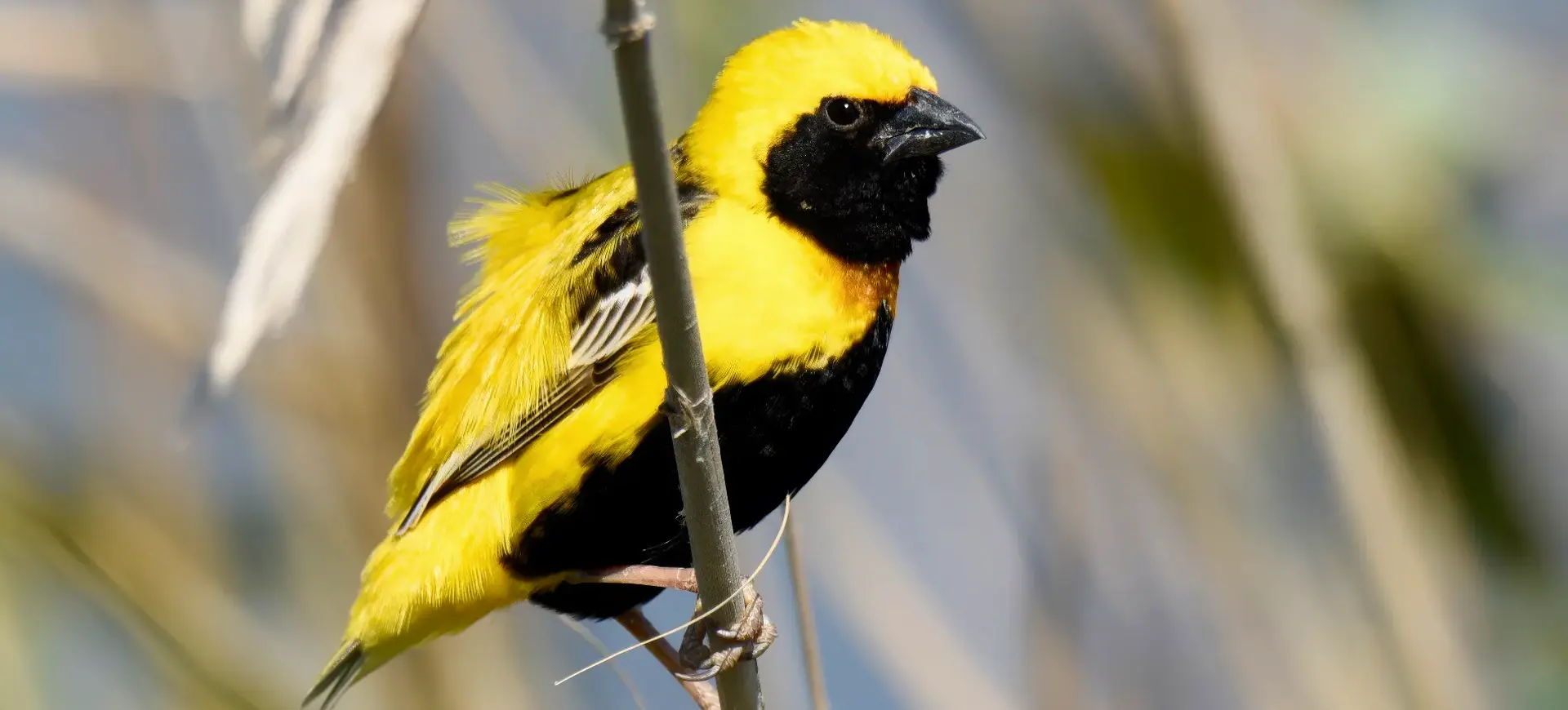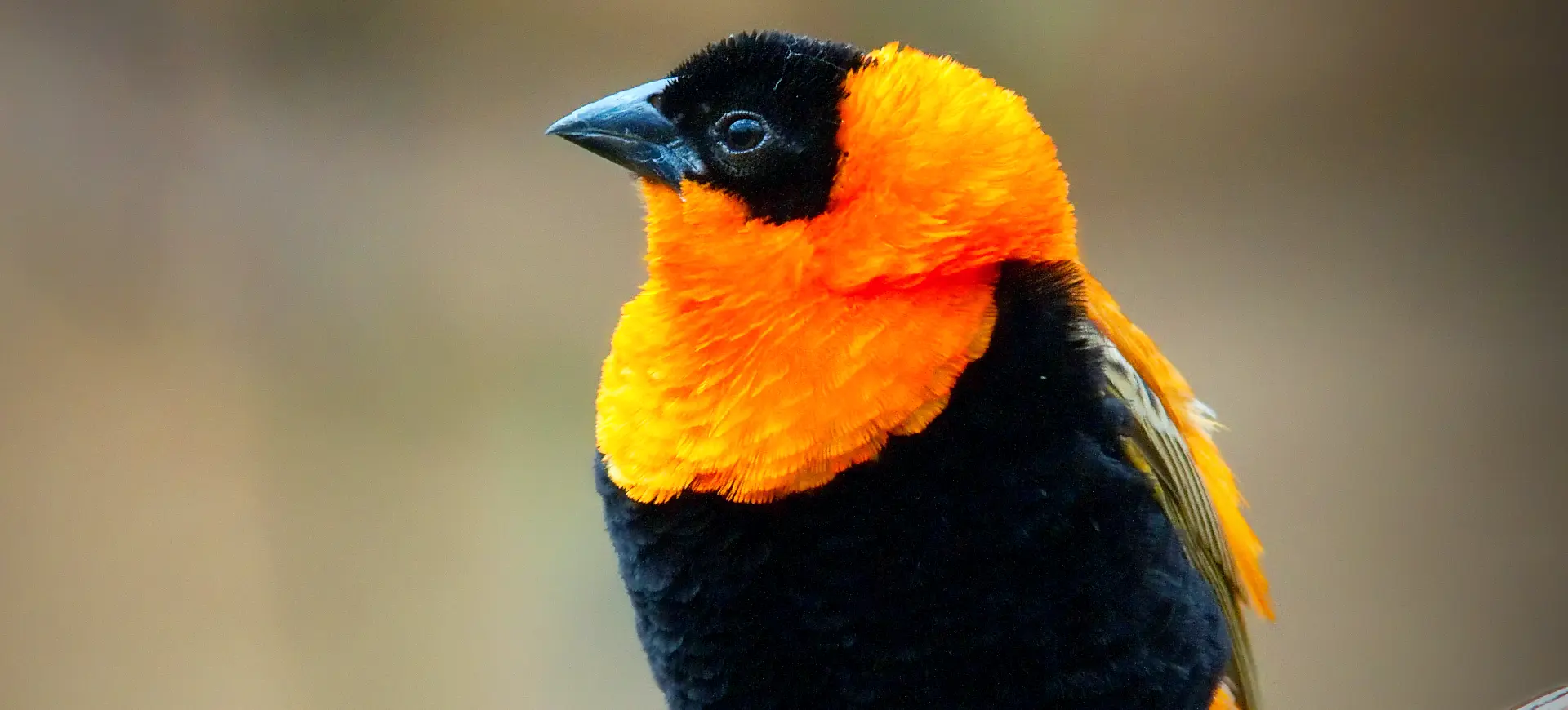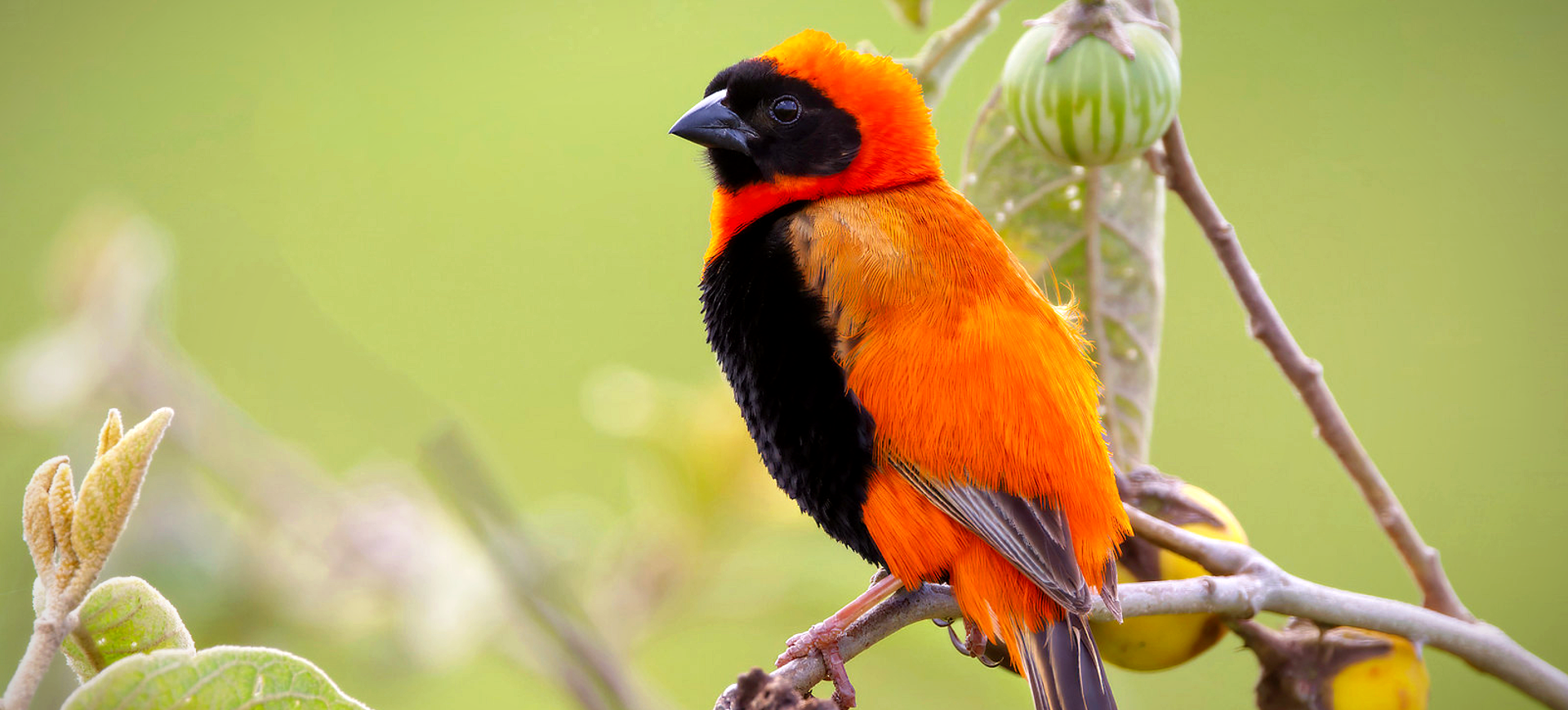Overview
The Chestnut Weaver, scientifically known as Ploceus rubiginosus, is a striking species of bird found primarily in eastern Africa. Distinguished by its rich chestnut and black plumage, especially prominent in males during the breeding season, this species belongs to the weaver family, known for their intricate nest-building abilities. These birds inhabit savannas, open woodlands, and grasslands, often found near water sources. They feed predominantly on seeds and insects, adapting their diet to seasonal availability and breeding requirements.
Chestnut Weavers exhibit a remarkable social structure. During the breeding season, males form large colonies, where they display their vibrant plumage and build elaborate nests to attract females. The construction of these nests, made from woven grasses and suspended from tree branches, is a critical part of their mating rituals. Outside the breeding season, these birds can form mixed-species flocks, foraging together in a wide range of habitats, including agricultural fields, which shows their adaptability to different environments.
The Chestnut Weaver’s conservation status is less concern due to its wide distribution and stable population in suitable habitats across its range. However, habitat destruction and changes in agricultural practices pose potential threats to their natural habitats. Efforts to preserve their environments are crucial for ensuring the species’ long-term survival. Their role in ecosystems as seed dispersers and in controlling insect populations highlights the importance of the Chestnut Weaver in maintaining ecological balance.
Taxonomy
Kingdom
Phylum
Class
Order
Family
Genus
Species
Type
Current distribution:
Chestnut Weavers are found in a relatively continuous distribution across eastern Africa, from Ethiopia, Somalia, Kenya, and northern Tanzania. Their presence in these areas is closely linked to the availability of suitable habitats, which include savannas, open woodlands, and grasslands near water sources. Seasonal movements may occur in response to rainfall patterns, affecting food availability and nesting sites.
Despite the challenges posed by habitat destruction and changes in land use, the Chestnut Weaver has maintained stable populations in areas where their habitats are preserved. Conservation efforts are important for ensuring the species continues to thrive, emphasizing the need for sustainable land management practices that support biodiversity.
Physical Description:
The Chestnut Weaver is notable for its striking appearance, with males exhibiting a vibrant chestnut color interspersed with black markings across their back, wings, and tail during the breeding season. This colorful display is complemented by their bright yellow underparts, making them highly visible amidst the green foliage. Females and non-breeding males have a more subdued coloration, primarily brown and buff, which provides better camouflage against predators.
Their robust body, legs, and conical beak are well adapted for a diet including seeds and insects. The Chestnut Weaver’s tail is relatively short and squared, while its wings are rounded. These traits provide agility and speed in flight, crucial for escaping predators and foraging. The difference in plumage between the sexes and according to the breeding cycle is a common trait among weavers, reflecting the species’ reproductive strategies and social behaviors.

Lifespan: Wild: ~3 Years || Captivity: ~10 Years

Weight: Male: 1.12-1.3 oz (32-37 g) || Female: 0.88-1.05 oz (25-30 g)

Length: Male & Female: 5.5-6.3 in (14-16 cm)

Top Speed: 20 mph (32 km/h)
Characteristic:
Native Habitat:
Chestnut Weavers are native to eastern Africa, extending from Ethiopia and Somalia to Kenya and northern Tanzania. They prefer savannas, open woodlands, and grasslands near water sources. These habitats provide the necessary resources for nesting, foraging, and breeding, making them essential for the species’ survival.
The preservation of these natural habitats is vital for the Chestnut Weaver, as it ensures the availability of food and nesting materials. The species’ habitat preferences highlight the importance of conserving these ecosystems for the Chestnut Weaver and the myriad of other species that share these environments.
Biomes:
Biogeographical Realms:
Continents:
Diet:
Diet & Feeding Habits:
Chestnut Weavers primarily feed on seeds and insects, exhibiting flexibility in their diet that allows them to adapt to the changing availability of food sources throughout the year. During the breeding season, the consumption of insects increases, providing the necessary proteins for egg production and feeding their young. They forage in flocks, using their strong beaks to extract seeds from grasses and capture insects.
In agricultural areas, Chestnut Weavers can benefit from crops and stored grain, although this can sometimes bring them into conflict with farmers. Their feeding habits contribute to the control of insect populations, offering natural pest control, and they play a role in seed dispersal, aiding in the regeneration of plant life. The adaptability of their feeding habits is key to their survival in various habitats, highlighting the importance of maintaining diverse ecosystems for these birds.
Mating Behavior:
Mating Description:
Chestnut Weavers are known for their elaborate mating rituals, which involve males constructing intricate nests to attract females. The males’ vibrant breeding plumage and ability to build multiple nests are key factors in attracting mates. These nests, woven from grasses and suspended from tree branches, testify to the male’s suitability as a partner. Females inspect the nests and the males’ displays before choosing where to lay their eggs.
After mating, the female is responsible for incubating the eggs and feeding the young, with the male often guarding the nest and its surroundings. The breeding season is a time of heightened activity and social interaction within Chestnut Weaver colonies, with males displaying aggressiveness to rivals and attentiveness to potential mates. A male’s success in attracting females is influenced by the quality of his nest and display, highlighting the role of these behaviors in the species’ reproductive success.
Reproduction Season:
Birth Type:
Pregnancy Duration:
Female Name:
Male Name:
Baby Name:
Social Structure Description:
Chestnut Weavers exhibit a complex social structure, forming large colonies during the breeding season. These colonies are characterized by numerous nests, each constructed by a male to attract females. Outside the breeding season, Chestnut Weavers may join mixed-species flocks, foraging and moving together in search of food. This social flexibility allows them to adapt to changing environmental conditions and the availability of resources.
The breeding season brings out the competitive nature of males as they vie for the attention of females, leading to dynamic and sometimes aggressive interactions within colonies. The social behavior of the Chestnut Weaver, from colony formation to mixed-species flocking, plays a crucial role in their survival and reproductive success, reflecting the importance of social structures in the natural world.
Groups:
Conservation Status:
Population Trend:
The IUCN currently classifies chestnut weavers as Least Concern, reflecting their stable population levels and wide distribution across eastern Africa. Their adaptability to various habitats and flexibility in diet have been crucial to their ability to maintain healthy populations. Regular monitoring is necessary to ensure that changes in land use and habitat destruction do not negatively impact their numbers.
Conservation efforts focusing on habitat preservation and sustainable agricultural practices are key to supporting Chestnut Weaver populations. By protecting the savannas, open woodlands, and grasslands that these birds call home, conservationists can help ensure the species’ continued prosperity.
Population Threats:
The primary threats to the Chestnut Weaver include habitat loss and degradation, particularly due to agricultural expansion and land clearing for development. Changes in agricultural practices, such as the increased use of pesticides, can also affect their food sources and nesting materials. Climate change poses an additional threat, potentially altering the habitats and food availability for the Chestnut Weaver.
Conservation strategies that address these threats are crucial for the species’ survival. Protecting natural habitats, regulating pesticide use, and implementing sustainable land management practices are essential measures that can mitigate the impacts of these threats on Chestnut Weaver populations.
Conservation Efforts:
Conservation efforts for the Chestnut Weaver are focused on habitat protection and ecosystem management that supports biodiversity. Initiatives aimed at reducing agriculture’s impact on natural habitats, such as promoting sustainable farming practices and creating buffer zones around protected areas, can benefit the Chestnut Weaver and other species.
Education and awareness campaigns that highlight the chestnut Weaver’s importance and role in the ecosystem can also foster conservation action at the local level. Collaborative efforts between governments, conservation organizations, and local communities are key to the effective conservation of the Chestnut Weaver and the preservation of its natural habitats.
Additional Resources:
Fun Facts
- Chestnut Weavers can construct multiple nests, each a complex structure woven from grasses.
- Males display a dramatic change in plumage color during the breeding season to attract females.
- These highly social birds form large colonies during breeding, where nests are built nearby.
- Their diet shifts from seeds to more insects during the breeding season, supporting the increased energy needs for reproduction.
- Chestnut Weavers play a significant role in their ecosystems as seed dispersers and natural pest controllers.
- The species’ adaptability to different habitats has helped maintain stable populations despite environmental changes.
- Conservation efforts for the Chestnut Weaver focus on habitat preservation and sustainable land use practices.
- The intricate nests of the Chestnut Weaver are functional and serve as a key factor in mate selection.
- Despite their vibrant appearance during the breeding season, Chestnut Weavers adopt more subdued colors outside this period for camouflage.
- Their social structure changes significantly between the breeding and non-breeding seasons, showcasing their adaptability to different social environments.


